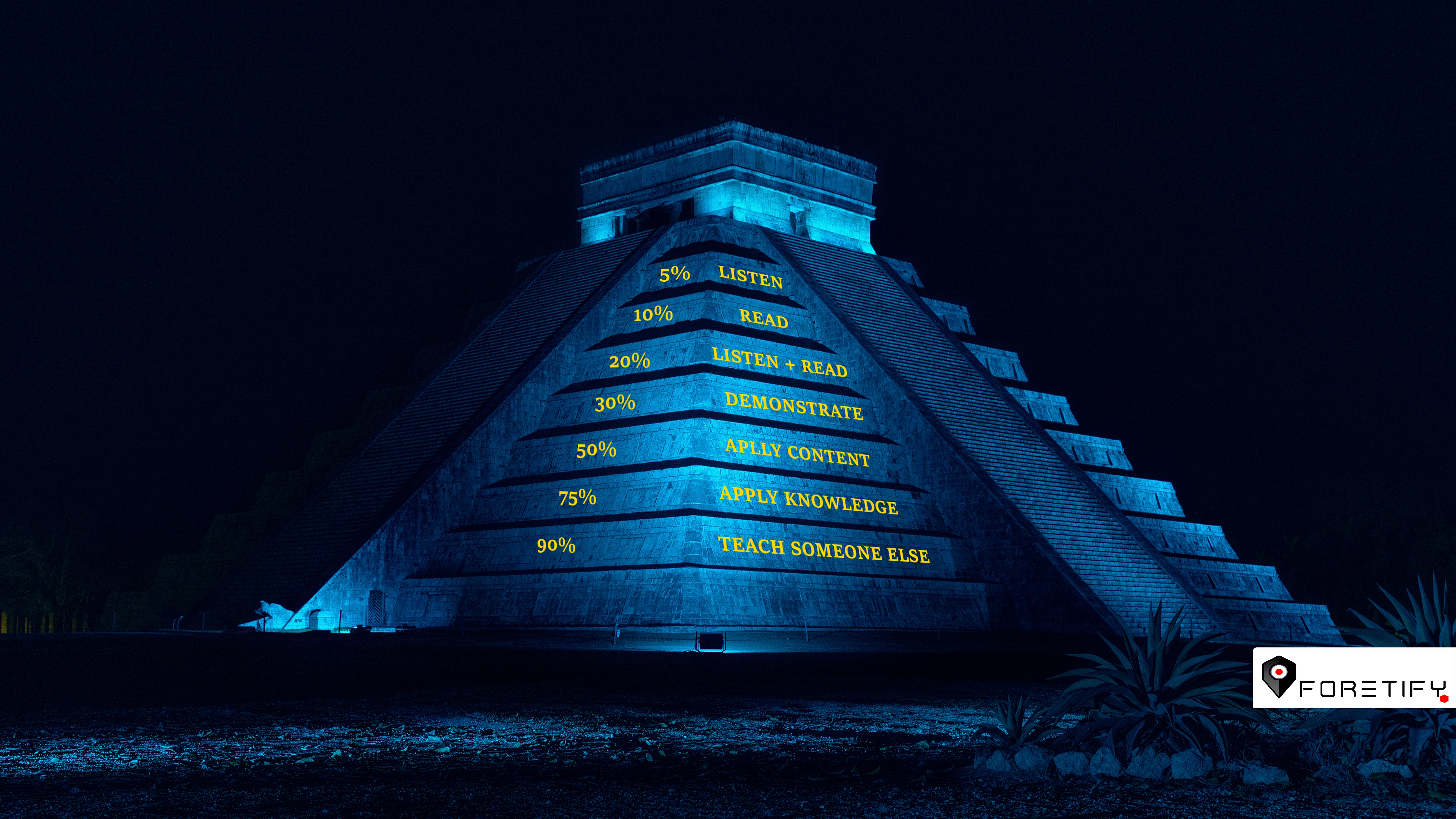
- On 3 Nov 2023
- In Technical Learning,
- Tags: Tips and Tricks, Technical Learning,
Understanding the Learning Pyramid
In the fast-paced world continuous learning and development are key to staying competitive and ensuring growth. One valuable concept that can help organizations achieve this is a method known as " The Learning Pyramid." This is a representation of a structured approach to learning that can empower anyone to thrive in their roles and contribute to success.
The Learning Pyramid is a visual representation of different learning methods and their respective effectiveness in retaining information. This is something that when put into practice gives an individual steps on how to grow when growth is not always clear. It was developed by the National Training Laboratory, and it categorizes various learning approaches. We have broken this into seven levels, each with its own impact on knowledge retention:
Listen (5% Retention): Traditional lectures have the lowest retention rate. While they are useful for conveying information, they are often passive learning experiences, and people tend to retain only a small fraction of what they hear. You could add YouTube videos to this category as well.
Read (10% Retention): Like lectures, and instructional videos reading materials provide a low retention rate. However, it allows people to learn at their own pace and revisit information when needed.
Listen and Read (20% Retention): Using visual aids and multimedia presentations can enhance retention compared to lectures and reading alone. It appeals to different learning styles and can make complex concepts more understandable.
Demonstrate (30% Retention): Hands-on demonstrations, simulations, and interactive training sessions increase retention significantly. People learn by doing, which often leads to a deeper understanding of the material.
Apply Content (50% Retention): Take the content that you are learning and apply it to focused projects, skunk work projects, or solutions that the rest of the world can benefit form.
Apply Knowledge (75% Retention): Collaborative learning through group discussions, hackathons, workshops, and peer-to-peer interaction can be highly effective. People learn from each other's experiences and perspectives.
Teaching Someone (90% Retention): The highest retention rate is achieved when people teach what they have learned to others. This not only reinforces their own knowledge but also contributes to the growth of their colleagues.
Applying the Learning Pyramid in Your Life
These examples that can help you understand the Learning Pyramid and how these concepts foster growth and development:
Diversify Learning Methods: Recognize that not all people learn the same way. Offer a mix of learning opportunities, including lectures, reading materials, multimedia presentations, hands-on workshops, and group discussions to cater to different learning preferences.
Interactive Training: Prioritize interactive and hands-on training sessions whenever possible. These experiences have a higher impact on retention and can boost skill development.
Peer Learning: Encourage a culture of peer learning where employees share their knowledge and experiences. Consider setting up mentoring programs or cross-functional teams to facilitate knowledge transfer.
Teaching Opportunities: Empower people to become teachers themselves. Encourage them to lead training sessions, workshops, or knowledge-sharing sessions within the company. This not only solidifies their own understanding but also promotes a culture of continuous learning.
Feedback and Evaluation: Regularly assess the effectiveness of your training programs and adjust them based on feedback. Measure the impact of different learning methods and how it impacts performance and knowledge retention.
Promote Lifelong Learning: Emphasize that learning does not stop after initial training. Encourage your people to pursue further education, attend workshops, join focus groups, and stay updated with industry trends to support their continuous growth.
Considerations and Alternatives for Learning Methods
While the Learning Pyramid can be valuable, it is not a one-size-fits-all solution. Factors like diverse learning styles, material complexity, and resource constraints can affect its effectiveness. Industry-specific requirements and the need for employee engagement also play a role. To address the limitations of this method here are consider alternative approaches that could be worth exploring:
Blended Learning: Combine different methods like e-learning, instructor-led training, and hands-on workshops.
Microlearning: Break learning into bite-sized modules for flexibility and just-in-time learning.
Mentoring and Coaching: Pair experienced peers with beginners for knowledge transfer and community-building.
Gamification: Make learning engaging with gamified elements that boost motivation and retention.
We aspire to craft this blog to inspire individuals on their lifelong learning journey, enabling them to consistently enhance their skills and passions. Although this concept has been circulating for some time, it remains a powerful idea. However, what if you find yourself in a state of stagnation? Our aim with this writing is to offer inspiration and guidance to help you break free from such inertia and reignite your progress.
Join our mailing list!
Did you find what you need?
For more information or a product demonstration, please feel
free to reach out.
Contact us
Lyle Wright, the founder of Foretify, LLC, boasts a computer science background and a deep passion for machine learning, artificial intelligence, and GIS. His innovative prowess has earned him a reputation for tackling complex challenges across various industries. Lyle's expertise in these cutting-edge fields drives Foretify, LLC, to deliver groundbreaking solutions that bridge the gap between theory and practicality. His visionary leadership ensures that the company remains at the forefront of technology, making a significant impact in an ever-evolving landscape.